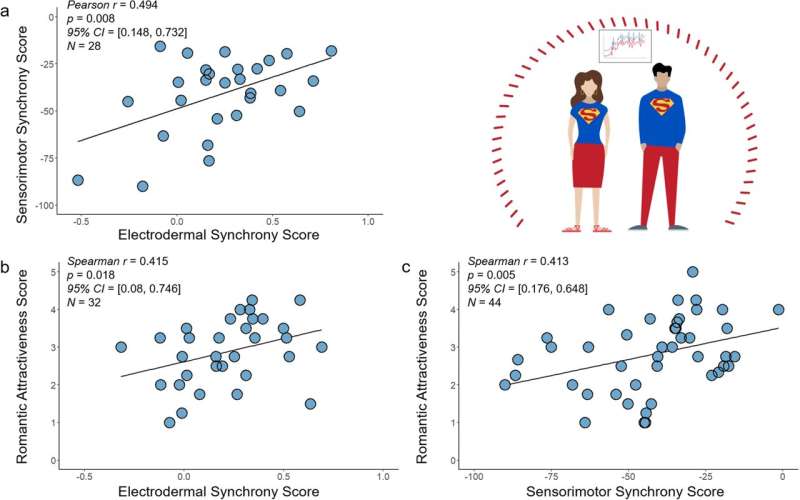July 6, 2024 feature
This article has been reviewed according to Science X's editorial process and policies. Editors have highlighted the following attributes while ensuring the content's credibility:
fact-checked
peer-reviewed publication
trusted source
proofread
Study links social and non-social synchrony to romantic attractiveness

Romantic relationships and attraction among humans have been the focus of numerous psychological and neuroscientific studies. While these studies have unveiled some of the neural and mental processes associated with romantic bonding, many questions about their underlying mechanisms remain unanswered.
Researchers at the Hebrew University of Jerusalem recently carried out a study exploring how physiological synchrony between individuals contributes to their romantic bonding. Their findings, published in Communications Psychology, suggest that greater synchrony with another person can boost the extent to which they are perceived as romantically attractive.
"We aimed to discover a biological mechanism that impacts mate selection in humans and how the ability to synchronize can signify fitness," Dr. Shir Atzil, co-author of the paper, told Medical Xpress. "We hypothesized that the ability to synchronize stems from fundamental sensorimotor abilities and that this adaptability might be perceived as beneficial in romantic contexts."
The idea behind this recent study by Dr. Atzil and her colleagues is that physiological synchrony between individuals could contribute to their mutual attraction. The rationale behind this is that synchronized physiological states between two people can facilitate the regulation of bodily systems, ultimately enabling more fulfilling interactions between them.
"Since we hypothesized that the complex social behavior of synchrony is actually anchored in domain-general sensorimotor features, we measured participants' ability to synchronize, both socially, where we measured the participants' ability for physiological synchrony with their partners during a date, and in a sensorimotor synchronization task, where we measured the participants' ability to synchronize their finger tap to a metronome bit," Dr. Atzil explained.
"We also acquired attraction ratings for all of our participants."
The researchers first carried out an initial online experiment involving 144 participants. These participants were asked to watch short videos in which a male and a female actor interacted with each other, exhibiting either a low or high physiological and behavioral synchrony.
After watching this video, they were asked to rate the attractiveness of the male and female actors. In addition, they were asked to rate how attracted they felt the male actor was to the female actress, and vice versa. Finally, as a last question, they were asked how behaviorally synchronized they believed the two characters in the video to be.
The researchers found that greater synchrony between the actors in the videos increased the attractiveness ratings provided by the study participants. Dr. Atzil and her colleagues then conducted a follow-up study in person, involving 48 participants.
These participants were asked to interact with potential partners in a speed dating experiment. Each interaction lasted five minutes and once it was complete, participants were asked to rate the attractiveness of the person they had just dated with and complete a tapping task designed to measure their synchronization.
During the speed dates, the researchers collected physiological data from the participants using a wearable device called the Empatica E4 wristband. This device measured the activation of the sympathetic nervous system, the secretion of sweat and changes in electrodermal activity.
"We see that the ability to synchronize is stable across tasks and across partners. Some people are super synchronizers, and super synchronizers are consistently rated as more attractive," Dr. Atzil said.
Overall, the findings gathered by these researchers suggest that greater physiological synchrony with another person increases the extent to which this person is perceived as romantically attractive. This observation confirms their initial hypothesis, suggesting that synchrony with others could have evolutionary and cognitive advantages, which could make more appealing as potential mates.
The recent research led by Dr. Atzil, along with colleagues Matan Cohen and Prof. Merav Ahissar, could soon pave the way for further studies exploring how physiological synchrony impacts romantic attraction. Collectively, these works could lead to new fascinating discoveries about the complex processes underpinning mate selection among humans.
"The most important finding of this study is that synchrony is a domain general individual aptitude, which signifies romantic attraction," Dr. Atzil added. "We plan to study and characterize super synchronizers and their neural, behavioral, and physiological profile."
More information: M. Cohen et al, Social and nonsocial synchrony are interrelated and romantically attractive, Communications Psychology (2024). DOI: 10.1038/s44271-024-00109-1
© 2024 Science X Network




















